WHAT'S NEW
ACROSS THE WORLD
Select date in side bar to go to a What's
New of previous issues
| What's New ©by
Laif DeMason
I think everyone is ready for this
winter to be gone! As of this writing, a series of winter snowstorms
have hit parts of the South, Midwest, Atlantic, and Northeast. Several
extreme cold weather events have also occurred, even in Florida where
many tropical fish are raised. The first two weeks of January gave
Florida some record-breaking cold. Here in Miami, the day time
temperature only broke 70º F once in 14 days. (This hasn’t
occurred since the late 1800s!) Every night brought lows into the 40’s
and high 30’sº F, ultimately bringing below freezing weather the
last few nights. Every Florida fish farmer pumped as much warmth and
warm water into their systems as possible, but many could not match the
cold weather onslaught. Farmers lost thousands of tropical fish. Most
tropical fish can only take low water temperatures to about 55º F;
they die in a few hours. So along with the Florida citrus and vegetable
farmers, fish farmers were up every night battling the cold to save
their crops. So don’t quit your day job just yet!
Here’s “what’s new” on the cichlid
scene:
|
Lake Tanganyika
Seemingly, Tanganyikan fish are the favorites for Rift Lake
hobbyists in many countries. There is strong interest in Tropheus, goby
cichlids, odd balls, and of course blue Cyphotilapia frontosa
varieties. Fish collected in the southern Congo coast seem to be in
demand, but costs to do business there continue to rise. Several old
time collectors and new upstarts have decided it is just too expensive
to collect far off fishes. Due to the bad economy and high expenses,
some have given up all together.
|
what's
new: Lake Tanganyika
|

Collected along the central Tanzanian
coast, this Petrochromis orthognathus
“red eye” is named for the bright color patches above the eyes.
Advanced hobbyists continue to try their hands at keeping several
species of these brutes.
|

One of the few species collected over
the past year or two in extreme northern Congo is Asprotilapia leptura. This fish is
from Uvira, Congo, and looks similar to the other populations of this
fish around the lake.
|

Exported from Tanzania, but collected in
southern Congo, Eretmodus sp.
Kamakonde is similar to the populations found elsewhere in the area
(see E. sp. Moba last issue.) These fish are spotted in blue dorsal
dots and also sport faded yellow body bars.
|
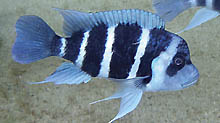
Still popular with hobbyists that can
afford them, Cyphotilapia frontosa
from southern Congo are highly regarded for their deep blue colors.
Pictured here is the variety from Moba, Congo, swimming underwater in a
Florida breeding vat. Photo by R. Martin.
|
Lake Malawi
Sales of wild caught Malawi fishes have been very low in the
United States and parts of Europe. Many hobbyists are opting for less
expensive bred fishes from Florida or local European breeders. As costs
of importation slowly rise, and the economic crisis continues, demand
for expensive wild Malawi fish has dropped. There is always the
occasional hobbyist searching for hard to find cichlids and sometimes
they are rewarded when the special order arrives.

Fully colored male haplochromines from
Malawi are often bought just for display purposes. Here a fully colored
male Otopharnyx sp. ‘spots’,
a seldom seen cichlid from the south-central Malawi coastline. Photo by
F. Callegari. |

Some male predatory haplochromines are
especially beautiful when fully or seasonally colored up in their
breeding dress. The Buccochromis
species seem often to fit the bill especially when extra large.
Pictured here is a male B.
nototaenia. Photo by F. Callegari. |

Several of the male Placidochromis varieties have
gained popularity among Malawi fans. A male Placidochromis sp. ‘jalo’ becomes
especially beautiful when grown out over time. Compared to newly
imported individuals, the color and finnage are spectacular. Photo by
F. Callegari. |

Rarely exported from Malawi is another
species, Placidochromis sp.
‘phenochilus gissel’. Not as strikingly colored as the P. phenochilus from the northern
end of the lake, this newer variety is not as bright iridescent blue,
but somewhat darker in contrast. Photo by F. Callegari. |
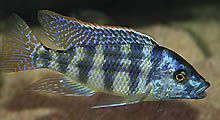
Gaining recent popularity, Placidochromis johnstoni is a
cichlid that was collected and exported in the late 1970s. A few of
these old time species are gaining notoriety from the newer generation
of Malawi cichlid hobbyists. Many of these species are difficult to
collect now and are supplied from farm raised sources. Photo by F.
Callegari. |
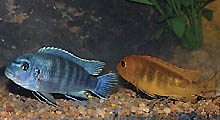
Pseudotropheus
heteropictus from Chizumulu has been shipped infrequently over
the past year or so. The males are powder blue and the females are
orange, making them a very colorful item to breed and something
hobbyists will buy as juveniles. |
Lake Victoria
No news of any wild caught items, but there are still pockets
of Victorian cichlid fans in different parts of the world. Often one
area’s group of hobbyists has a species that another hasn’t seen in
some time. Hopefully, with exchanges of species and dedicated hobbyists
breeding these fishes, current species will not disappear from the
hobby in the future.
what's
new: Lake Victoria
|

Bred in some places in Europe, Lipochromis melanopterus sometimes
sent to America and elsewhere as bred juveniles. Other hard to find
species can sometimes be sourced this way. Photo by O. Seehausen. |

Developed by select breeding from the
Uganda variety called ‘Haplochromis’
sp. ‘red fin piebald’, this Florida farmed variety is now sold as
‘Fluorescent Pink.’ In this underwater photo, one can see why. Photo by
R. Martin. |
Neotropics
Exports from the usual South American countries have been
active of late. While some countries like Brazil have restricted
trade in certain species and groups, other countries try to find and
collect similar species from their own regions to fill any demand
gap. Some different and no so often collected cichlids are
arriving from these places as well.

Small numbers of Geophagus pellegrini are finally
being shipped from Colombia. Hopefully, this beautiful species will
stay in the hobby this time around. Photo by O. Lucanus. |

This very interesting cichlid hails from
Colombia as well. Often sold as Cichlasoma
ornatum (or C. gephyrum),
its true identity is uncertain. Photo by O. Lucanus. |
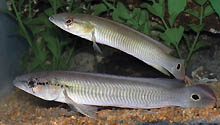
While many Crenicichla species are restricted
from the trade in Brazil, other countries are still shipping their
native species. Exported and sold from Colombia as Crenicichla sp. ‘Orinoco,’ this
unidentified pike cichlid could be related to the strigata group of
pikes.
|
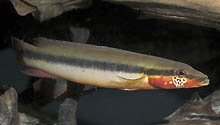
Crenicichla
multispinosa are finally starting to be shipped out of
Surinam. This attractive pike cichlid gets too large for most
aquariums, but it is one of the most colorful and elegant
species. Photo by O. Lucanus.
|
Select date in side bar to go a What's
New of previous issues
|















